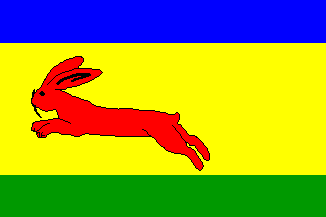 Shipmate Flagchart : http://www.shipmate.nl/flags.htm
Shipmate Flagchart : http://www.shipmate.nl/flags.htm
adopted 1963

Last modified: 2003-09-20 by jarig bakker
Keywords: gaasterland |
Links: FOTW homepage |
search |
disclaimer and copyright |
write us |
mirrors
 Shipmate Flagchart : http://www.shipmate.nl/flags.htm
Shipmate Flagchart : http://www.shipmate.nl/flags.htm
adopted 1963
![[Balk villageflag]](../images/n/nl-fr0bk.gif) by Jarig Bakker, 18 Aug 2003
by Jarig Bakker, 18 Aug 2003
Balk is a sleepy little village, and seat of Gaasterlân-Sleat
- the river Luts is one of my favorites, when, while sailing on the Frisian
lakes, the wind is too strong, you take a long loop through some canals
and the Luts, passing along "Kippenburg", a pub where you have to serve
yourself. But beware of the fierce flow of the Luts: it is said that in
the wild old days the water reached speeds of two meters per hour!
CoA: in gold a green wavy pale, over which a red shortened fess charged
with a golden six-pointed star; in gold with four green stemmed linden-leaves
2-2; in chief a "vlecke-kroon" (townlet-crown) of gold, joined red, with
three red lozengy stones and two green oval stones and on the bandeau a
wreath fastened of three leaves and two pearls.
Flag: a red hoist with a length of 1/4 flaglength with in the center
a yellow six-pointed star, the fly of three equally wide horizontal stripes
yellow - green - yellow with in the top towards the hoist a green stemmed
lindenleaf.
The green pale is the river Luts, which streams through this "vlecke",
formerly seat of the "grietenij" Gaasterland, over which the local red
bridge (is "balk), charged with the golden leading star, symbolizing the
"grietenijhuis" (former municipal council-house). the color red of the
red hare from the municipal arms before the golden corn-plant. The four
lindenleaves refer to the ancient linden-hedge along the quay of the Luts,
which was described in the poem of the Dutch auther Gorter "Mei" - May,
in which this townlet is described.
Balkh is one the the known Frisian "vlekken" (townlets), and is entitled
to a "vlekken-kroon".
Design: R.J. Broersma, member of the Fryske Rie foar Heraldyk
Sources: Genealogysk Jierboekje 1989.
Vexilla Nostra jg. 23 (nr. 159) pp. 107-108.
Jarig Bakker, 18 Aug 2003
I am sorry to nitpick, but it is a known fact that people in the ancient times tended to exaggerate the specific characters of their villages. A more conservative estimate of the Luts flow speed would be two meters per day, except on those very windy days